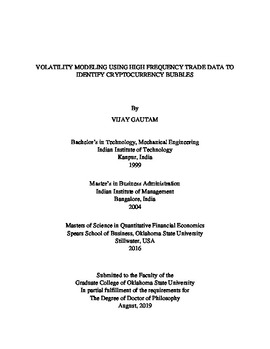| dc.contributor.advisor | Carter, Dave | |
| dc.contributor.author | Gautam, Vijay | |
| dc.date.accessioned | 2020-01-30T15:03:05Z | |
| dc.date.available | 2020-01-30T15:03:05Z | |
| dc.date.issued | 2019-08 | |
| dc.identifier.uri | https://hdl.handle.net/11244/323345 | |
| dc.description.abstract | In the light of sudden interest in Bitcoin during 2017, which saw Bitcoin growing multifold in market price, I study blockchain, Bitcoin and few other top cryptocurrencies, and examine whether Bitcoin was in a financial bubble during late 2017 and early 2018, when Bitcoin price had a sudden and dramatic run up. I conduct statistical analysis on the High Frequency Trade (HFT) data, sourced from Bloomberg and other crypto exchanges. The statistical analysis includes filtering in price data using 5%, 7% and 10% daily price jump rules (considered separately), interpolating price points between low and high prices in the time series, estimating price volatility at discrete price points, analyzing the volatility behavior and concluding whether or not price process is a strict local martingale. A bubble is confirmed if the price process is a strict local martingale, and not a true martingale. I run the test for Bitcoin, and find that Bitcoin was in intermittently in a bubble during the years 2017 and 2018. I repeat the test for Ethereum, another top trading cryptocurrency, and find that Ethereum was in a bubble during Nov 2017 - Feb 2018, but infrequently and for lower duration of days as compared to Bitcoin. Though Bitcoin price dramatically increased during 2017, the number of transactions and transactions volume rather fell. I develop a statistical test that can be applied on the High Frequency Trade (HFT) data of any highly traded asset to identify whether or not that asset has been in a bubble during the period of consideration. I also find that Bitcoin has positive correlation with other top cryptocurrencies and almost zero correlation with S&P 500, gold, and the crude oil. | |
| dc.format | application/pdf | |
| dc.language | en_US | |
| dc.rights | Copyright is held by the author who has granted the Oklahoma State University Library the non-exclusive right to share this material in its institutional repository. Contact Digital Library Services at lib-dls@okstate.edu or 405-744-9161 for the permission policy on the use, reproduction or distribution of this material. | |
| dc.title | Volatility Modeling Using High Frequency Trade Data to Identify Cryptocurrency Bubbles | |
| dc.contributor.committeeMember | Simkins, Betty | |
| dc.contributor.committeeMember | Eaton, Greg | |
| dc.contributor.committeeMember | Li, Weiping | |
| dc.contributor.committeeMember | Syed, Imran | |
| osu.filename | Gautam_okstate_0664D_16333.pdf | |
| osu.accesstype | Open Access | |
| dc.type.genre | Dissertation | |
| dc.type.material | Text | |
| dc.subject.keywords | blockchain | |
| dc.subject.keywords | cryptocurrency | |
| dc.subject.keywords | bitcoin | |
| dc.subject.keywords | discrete observations | |
| dc.subject.keywords | financial bubble | |
| dc.subject.keywords | volatility estimation | |
| dc.subject.keywords | martingale | |
| dc.subject.keywords | stochastic volatility | |
| dc.subject.keywords | strict local martingale | |
| dc.subject.keywords | diffusion | |
| thesis.degree.discipline | Business Administration | |
| thesis.degree.grantor | Oklahoma State University | |
